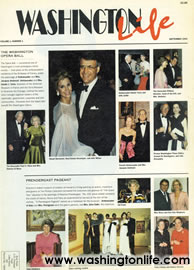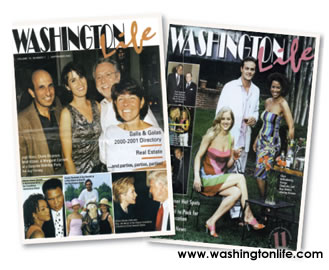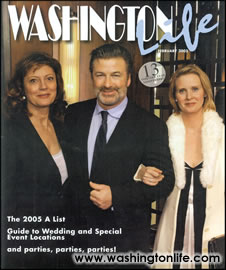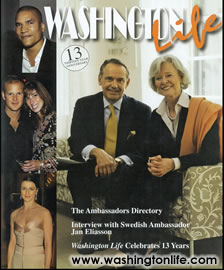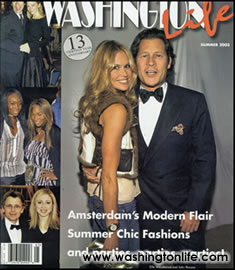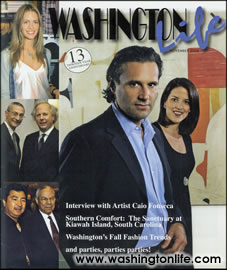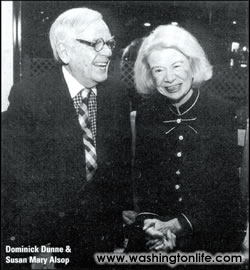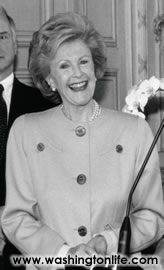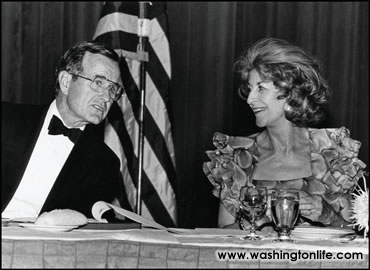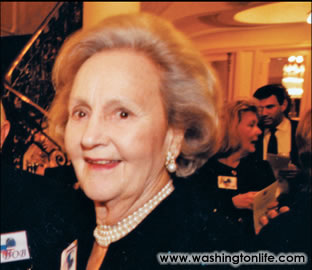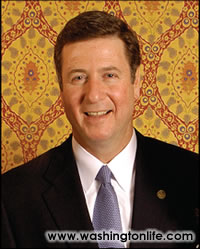15 YEARS OF WASHINGTON LIFE… WE'VE COVERED IT ALL!
SOCIALLY
SEASONED
The more things have changed socially in Washington in the past decade and a half, the less change there seems to be. With a few qualifi cations. The same charity events continue on, with many of the same faces in charge. Recall, and tack on the words "gala" or "ball" to: Wolf Trap, American Cancer Society, Washington National Opera, Corcoran Gallery of Art, the Washington Ballet, Washington Performing Arts Society, Fight Night. There are, of course, a few newer events on the black-tie circuit: the Mosaic Foundation, for example, run by (mostly unveiled) Arab ambassadors' spouses. Black gowns remain standby operative costumes (easy to stash in offi ce closets and they do help one blend into the crowd) but there has been a slight decline in what the purveyors of custom call "standards." The biggest sartorial switch was the retirement of white-tie mode to near oblivion. (Only the Gridiron Club now commands it for a restricted showtime audience.) Global calamities of 2001 dampened the ardor with the result that guests for the fi rst time were allowed only "optional" preference in their formal attire at that year's National Symphony Ball. Then the no-medals-and-tails option became the norm, after which the ball moved forward in the seasonal calendar to September to avoid the usual December Kennedy Center Honors jam. And while two women chairs were customary, along came husband-and-wife teams. Now even two men, at least outwardly, can take over the role. Jim Kimsey, the sly debonair man-about-town, and pal Joe Robert helped break the old rules at the Kennedy Center's spring gala a few years back. After all, Kimsey's 60th birthday celebration at the St. Regis in '99 was also a winner, complete with World War II décor and guests in 1940s dress. Royals still arrive with a fl ourish, but like Jordan's knockout gorgeous Queen Rania they now come with a mission to promote social well-being. Queen Noor, her predecessor who is now a Washington resident, also turns up regularly as mascot to the Good. So do telegenic ambassadorial spouses who have taken over the role which professional hostesses once performed. Wives such as Kuwait's Rima al- Sabah and Britain's (now departed) Lady Meyer lend cachet to tried-andtrue embassy occasions with their extra edge in fashion and smarts. Without them, Washington would be a far less glamorous place.
On an offi cial note, it seems a long time since happenings at the White House took the breath away. State Dinners have declined, partly out of the Bushes' personal preference and partly in keeping with the administration's reluctance to offer too much showy entertainment in wartime. By contrast, the White House Correspondents Dinner has become a celebrity-stalkers' boardwalk far removed from its original purpose as an off-the-record gathering of peers. But take heart: Robert Duvall does a wicked tango here on occasion, and philanthropist Catherine Reynolds can pull out all the stops, as she did for the patriotic themed affair she sponsored in the National Building Museum four years ago that featured entertainers Ray Charles, Quincy Jones, Aaron Neville, Frank Sinatra Jr., Michael Crawford and Patti Austin. If there has been a toning down of glitz in the past 15 years, it has not meant an elimination of style.
THE NEW
FACE OF
PHILANTHROPY
The greatest changes I have seen in Washington's social life over the last fi fteen years have been gradual, like the slow shifting of tectonic plates. Though the fi rst inklings of change began shortly before Washington Life saw print, the magazine has played a decisive role. Case in point: its continued recognition of the relevance of charity balls and galas, with their heavy ambassadorial involvement, that make Washington's social scene unique. Most obvious is the striking increase in younger participants involved in the charities this town holds dear. The door, once fi rmly closed to new causes whose fundraising might siphon off awaited dollars, has now been opened. Like the legendary Boston matron who answered, when asked where she got her hats, "We have our hats," we had our causes. They were unvaryingly funded and chaired by a list of regulars that was short in length but long on entrenchment. That's gone. Newcomers with big wallets have surged onto the scene. They now begin lending their support at an earlier age than did past patrons, so the change is not just due to natural attrition. Washington Life has consistently pictured and commented upon these newbies along with the established standard-bearers, and registered the fun they are fi nding in helping further good works.
With increased opportunities for wealth accumulation at an earlier age, they have the cash to fund the bash, and so have added new and needed causes to match their expanded awareness of the world. As a side note, because there is more money but less time available, entertaining has often shifted to the restaurant scene, which has changed to meet the demand. Fine dining in Washington, once limited to a few places, is now available at myriad restaurants, and the discovering and discussing of them is beginning to resemble the passion of those living in New York, where it rates as an intramural sport. This all adds up to a more vibrant social scene, built on the solid institutions of the past, and still anchored in providing help to others not only here at home, but half a world away.
GRANDES DAMES NO MORE
Recently I spent some time looking through issues of Washington Life from the early 1990s, back when both the magazine and I were new to covering the social scene. What captured my attention the most wasn't the changes in fashion or the ever-older faces on those glossy pages. What fascinated me were the photographs of the great Washington power hostesses in action. Intelligent, cultivated and strong willed, mostly widows of great longevity, these grandes dames had the ability to recognize or exclude others from access to information and contacts vital to rising careers. They had more power than most men, but usually managed to remain friendly - perhaps, as one wag put it, under the same principle that France and the U.S. are allies.
Looking at a picture of Susan Mary Alsop sitting beside Dominick Dunne at a 2000 party at Café Milano reminded me of the wonderful dinners she hosted in her Georgetown home. Everything was comme il faut one particular night when the noted historian and memoirist feted Tish Baldrige and Chris Buckley, mutual friends who had just published their own umteenth books. There were masses of red roses strategically arranged around her Gilbert Stuart and John Singer Sargent ancestor portraits, delicious food prepared by the longtime Italian cook (no caterer's fare ever entered that house!) plus the inevitable sparkling conversation and toasts. I still smile when I remember one breathcatching moment after the guests took their places at table. There came a a brief interlude of silence as everyone looked toward Susan Mary sitting at the far end. As if on cue, she picked up a tiny porcelain hand bell and deftly rang it precisely three times, after which the salver-bearing butlers burst through the kitchen door tout de suite. At the time I recall thinking that no one else in Washington could have presided over such an anachronistic scene with such perfect aplomb, although it was, of course, perfectly in keeping with the manner in which this utterly fascinating woman and her family (she was a direct descendant of John Jay and related to the Astors) had lived for more than two centuries.
Susan Mary was brittle in old age; I don't think I ever really heard her laugh. I came to realize that she had known many emotional hardships. But she was a brilliant conversationalist who delighted in discussing history, much of which she had directly experienced at the highest levels, especially during the period following World War II when she was a diplomatic wife living in Europe, and during the Kennedy "Camelot" era. She knew scores of royals and aristocrats and many top artists, writers and politicians. Astonishingly erudite, she had great tales to tell (generally over a few scotch and sodas) but always remained terribly discreet. Nothing untoward ever passed her lips, at least not to me. She always preferred to listen and learn. My dinner companion that night at Susan Mary's was Polly Wisner Fritchey, another Georgetown dowager who had been at the center of high level political and social life in Washington since World War II. After all, her fi rst husband, Frank Wisner, had been a cofounder of the CIA, and her second, Clayton Fritchey, a respected journalist. A master of the art of making people feel instantly comfortable ("Please do call me Polly"), she never failed to charm and was unfailingly supportive of many of the city's arts causes. She knew that people would be disappointed if she didn't show up at Shakespeare Theatre openings or PEN/Faulkner events at the Folger Library, and allowed herself to be "frogmarched in," as she once told me, even into her late 80s when she was feeling poorly. Polly was indomitable
Evangeline Bruce, by contrast, was always "Mrs. Bruce" (I once witnessed her insta-freeze a female acquaintance who had the effrontery to address her as "Vangie.") Multi-lingual and supremely well-connected after years en poste alongside her late husband, Ambassador David K. E. Bruce, in Britain, France, Germany and China, the couture-clad doyenne could be tough on arrivistes and held sway for decades as a worldclass social and fashion arbiter. It all boiled down to standards, I suppose, which she upheld to the end while quietly writing her excellent biography of Napoleon and Josephine and fundraising for Sasha Bruce House, a shelter for homeless and abused teens named after her daughter who had died of a mysterious gunshot wound. Toward the end of her life, I don't think Mrs. Bruce cared about entertaining much anymore, except where Sasha Bruce House was concerned, or if very special friends came to town. She became famous for the austerity of her hors d'ouevres (quail's eggs, caramelized bacon and other tiny rarities). Her guests often had a chuckle when they turned up after her receptions at the same Georgetown restaurants. Some people said she was actually quite shy, and if true, this explained much about her. The ever-captivating femme fatale Pamela Harriman was disliked by many of the other Old Guard ladies for a number of reasons, mainly her proclivity for husband-stealing, but was always quite popular with men. I was no exception, and she was certainly very kind to me. There was no logical reason why she should have agreed to contribute to the funky Washington guidebook I was putting together some years back, but she did. And she turned out for my book party as well. (All my friends were impressed.) Shortly before her death, when she was U.S. ambassador to Paris, she cordially received my family at the embassy even though I could tell she was terribly fatigued. I will always remember her as a gracious lady. I knew Katharine Graham least well. To be truthful, I hardly know her at all. After attending so many of the same events and being introduced many times over the years, however, I fi nally started chatting up the powerful publisher of what we at The Washington Times called the "O.P.," or Other Paper.
My favorite encounter involved the now extinct Nina Hyde breast cancer benefi t that she had co-founded with Vogue's Anna Wintour. Mrs. Graham took great pride in the event's success, which was one of the few Washington social affairs likely to be written up in New York as well as here. I was dutifully attending one year when I saw her make a beeline in my direction. "Have you seen the Post's reporter or photographer here?" she asked, knowing full well that I would have recognized the competition the minute I walked though the door. I had to break it to her. "Mrs. Graham," I said, "I don't think anyone from your paper is coming. I took a look at the press list when I arrived and no one from the Post is on it." "You're here covering my event, and my paper is not," she said, making more of a statement than a question. "I guess so," I replied. "I see," she declared, turning on her heel to La Wintour, who looked none too pleased to hear the news. I thought that was the last of it until evening's end, when I felt a little tug on my sleeve as I joined the exodus out the door. It was Mrs. Graham. "Thank you," she said. "I want you to know how much I appreciate your support." Mrs. Graham was famed for not using her owner's clout to interfere in the Post's editorial product. Nonetheless I fi gured that someone at the OP would likely catch it over this "missed opportunity." Sure enough, a major story about the event appeared in the paper two or three days later. I knew full well some poor scribe had been ordered by his or her editor to "cover" it in absentia - no easy task. I always thought of the incident when I saw Mrs. Graham after that, although I would never have dreamed of mentioning it. I grew rather fond of my image of her: a gracious lady, certainly, but one who had an iron fi st inside her velvet glove.
THE
COMMUNICATIONS
AGE: 15 YEARS
AND RUNNING When Washington Life asked me to talk about some of the changes that have taken place since 1991 when the magazine fi rst hit newsstands - and coincidentally when I fi rst came to Washington as a U.S. Congressman- I began to think about communications. In 1991, information in the nation's capital moved only as fast as the telephone, the fax machine, or the mail. Fifteen years later, Washington is a much "faster" town - as new technologies have made our one-on-one communications virtually instantaneous. With its growing online presence Washington Life knows about the power of the internet fi rst hand. The last decade and a half have seen dramatic changes in the way we communicate, conduct business, and live, from distance learning to telemedicine. Looking ahead to the next fi fteen years, we need to expand broadband Internet access and close the "economic digital divide." This past summer, I was on my annual Listening Tour across Virginia, and in many of the places I visited broadband is still an out-of-reach luxury. The easy access to information we take for granted in Washington and Northern Virginia with our pioneering AOL, cable modems, and DSL is clearly felt when you can't use it. This situation cannot continue, because in the 21st century, the Internet is an absolute necessity for economic expansion, opportunity, education, and jobs. We must also keep the Internet free of access taxes. In every culture, knowledge is power and by facilitating the free exchange of ideas and information, the Internet can empower individuals, and nurture the growth of freedom on every continent. Spurring innovation and sparking commerce is why increasing broadband Internet access (and preserving Internet freedom) is one of the paramount missions of our time. Let me conclude by wishing all of the writers, editors, and photographers at Washington Life a happy 15th birthday. Even as Washington and the world move faster and faster, you have kept the pace - and in fact, set the pace for lifestyle magazines in the Washington region. As great as your past and present have been, you have an even brighter future ahead of you. Keep adapting, keep innovating, keep improving, and keep winning!
|
|||||||||||||||||||||||||||||

